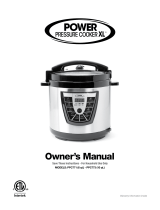
76
IMPORTANT SAFEGUARDS IMPORTANT SAFEGUARDS
13.
WARNING
This appliance cooks under pressure. Inappropriate use may
result in burns, injury and/or property damage. Make certain the appliance is
properly closed before operating. Refer to Pressure Control Features—
Pressure Cooking Lid.
14. When cooking meat with skin (e.g. sausage with casing), the skin can swell
when heated. Do not pierce the skin while it is swollen; this could result in
scalding injury.
15.
CAUTION
When pressure cooking food with a doughy or thick texture, or
a high fat/oil content, contents may splatter when opening the lid. Please
follow recipe instructions for pressure release method. Refer to Depressurizing
the Cooker (Venting Methods).
16.
CAUTION
Before each use, check the steam release valve/handle, steam
release pipe, anti-block shield and oat valve for clogging. Failure to do so
may result in injury or property damage.
17.
DANGER
Do not open the appliance until it has depressurized and all
internal pressure has been released. If the oat valve is still up and/or the lid is
difcult to open, this indicates that the appliance is still pressurized—do not
force it open. Any pressure in the appliance can be hazardous. Refer to
Depressurizing the Cooker (Venting Methods) for information on releasing
pressure. Opening appliance while it is still pressurized may lead to sudden
release of hot contents and may cause burns or other injuries.
18. Do not use this appliance for deep frying or pressure frying with oil.
19. Do not lean over or place your hands or face over the steam release valve/
handle or oat valve when the appliance is in operation or has residual
pressure. Do not touch the metal portion of the lid when the appliance is in
operation; this could result in injury.
20. Do not cover or obstruct the steam release valve/handle and/or oat valve
with cloth or other objects. Obstructing the steam release valve/handle and/or
oat valve can create a safety issue and may cause injury.
21. Turn the appliance off if steam escapes from the steam release valve/handle
and/or oat valve in a steady stream for longer than 3 minutes. There may
be residual pressure in the appliance. Allow the appliance to depressurize
naturally or release all excess pressure before opening. For more information
on how to release pressure, refer to Depressurizing the Cooker (Venting
Methods).
22. Turn the appliance off if steam escapes from the sides of the lid and ensure
sealing ring is properly installed. Overview of Pressure Control Features—
Sealing Ring for more information.
23. To disconnect, select Cancel, then remove plug from power source.
24. Unplug from the outlet when not in use, as well as before adding or removing
parts or accessories, and before cleaning. To unplug, grasp the plug and pull
from the outlet. Never pull from the power cord.
25. Regularly inspect the appliance and power cord. Do not operate the
appliance if the power cord or plug is damaged, or after the appliance
malfunctions or is dropped or damaged in any manner. For assistance, contact
Customer Care at support@instantpot.com or 1-800-828-7280.
26.
CAUTION
Do not let the power cord hang over edges of tables or
counters, or touch hot surfaces or open ame, including the stovetop.
27.
CAUTION
Spilled food can cause serious burns. A short power-supply
cord is provided to reduce the hazards resulting from grabbing, entanglement
and tripping.
• Keep the appliance and cord away from children.
• Never drape the power cord over edges of tables or counters.
• Never use below-counter power outlets, and never use with an
extension cord.
28. Intended for countertop use only. Keep the appliance on a stable, heat-
resistant platform. Do not place on anything that may block the vents on the
bottom of the appliance. Do not place on a hot stove.
29.
CAUTION
Do not use any accessories or attachments not authorized by
Instant Brands Inc. The use of attachments not recommended by the
manufacturer, may cause a risk of injury, re or electric shock.
30.
CAUTION
Before inserting the inner pot into the appliance, clean the
outer surface of the inner pot and the heating element located on the inner
surface of the outer pot with a clean, dry cloth. Ensure they are dry and free of
food debris.
31. Do not attempt to repair, replace, or modify components of the appliance, as
this may cause electric shock, re or injury, and will void the warranty.
Read this manual carefully and completely, and retain for future reference.
Failure to adhere to safety instructions may result in serious injury or damage.
Read this manual carefully and completely, and retain for future reference.
Failure to adhere to safety instructions may result in serious injury or damage.
WARNING
WARNING






















